|
Index...
|
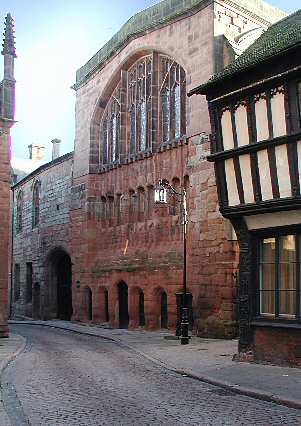
 n the right of this picture, the half-timbered building jutting out is 22 Bayley Lane. To the left is the ruins of St. Michael's cathedral.
n the right of this picture, the half-timbered building jutting out is 22 Bayley Lane. To the left is the ruins of St. Michael's cathedral.
The view of the Guildhall from the outside is deceptive. At first sight, it could be dismissed as just another medieval building. The stature of the place is not immediately obvious and it would be easy to walk past the semi-concealed courtyard and not give a second glance.
However, as you enter the well preserved courtyard, you begin to sense a certain air of importance about this place.
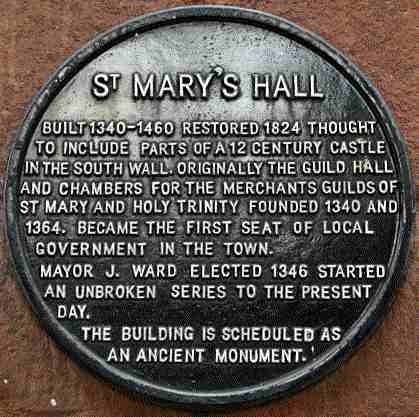
The plaque on the left gives a few salient points about the Guildhall.
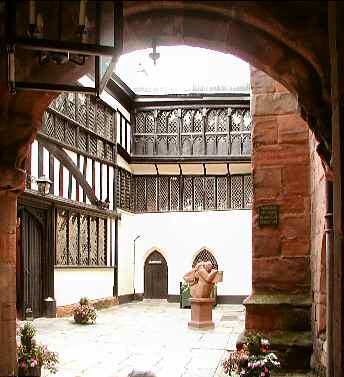
The view into the courtyard is much as it would have looked to visitors many centuries ago.
Once inside and up the staircase to the right into the Great Hall, the sight that confronts you is quite striking. (See the photo' below.) The ornate ceiling and stained glass window are the first things that greet you, but as you look around, huge life-size portraits, tapestries and beautiful decoration give the hall a sense of regal importance.
How did this Gateway look in 1829?
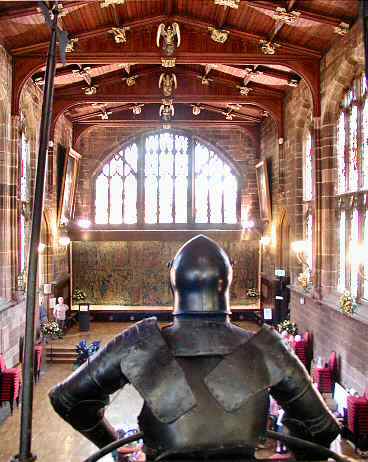
And importance it certainly has had. Between 1456 and 1459, King Henry VI and his Queen, Margaret of Anjou spent much time in Coventry after fleeing from London during the War of the Roses. During that time, St. Mary's Guildhall would have been the prime venue for entertaining the Royals and their court.
The huge tapestry and great north window (below) in the Great Hall commemorate "Henry and Margaret" and Henry's ancestors respectively, works which demonstrate the extremely deep respect that Coventry held for Henry VI; the King who made us a county. The tapestry was made in the early 1500s during the reign of King Henry VII (Henry Tudor), and was part of the veneration of Henry VI, his uncle, in an attempt to have him canonised - something which ultimately failed after Henry VIII's split with Rome.
To properly appreciate the window and the tapestry a visit to the guildhall is essential.
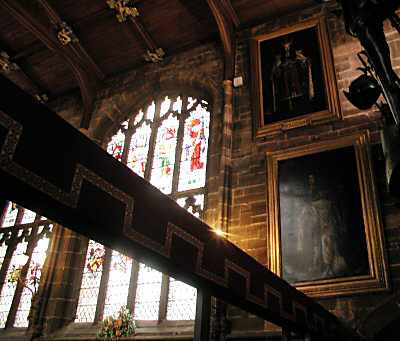
St. Mary's Hall has been famous for many other things in its time, perhaps one of the more interesting being that Mary Queen of Scots was imprisoned there for three months from November 1569 under the orders of Queen Elizabeth I.
Although it is often stated that she was held prisoner in Caesar's Tower, David McGrory reminds us that this was clearly not viable... the Scottish Queen was, at that point, merely being detained (partly for her own safety), not imprisoned, and would still have travelled with a small entourage. It is most likely that she stayed in the much larger Mayoress's Parlour.
Having previously been held at Tutbury, Mary was hurried to our walled and heavily defended city of Coventry before a band of northerners could seize her. She stayed for a short while at the old Bull Inn, Smithford Street, before being moved to the safer Guildhall. At this point there was also mention of the possibility that she could be kept in Coventry castle, but it was declared at that time to be too ruinous.
A letter that Elizabeth wrote to the people of Coventry still exists and a copy may be seen in the Guildhall.
The English translation of the letter is below:
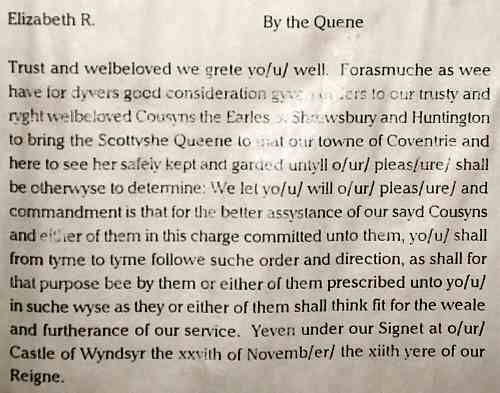

This next picture shows the Prince's Chamber.
This name is directly translated from "Camera Principis" which is the city's motto and can be found beneath the official Coventry Coat of Arms, an explanation of which can be found on the History page.

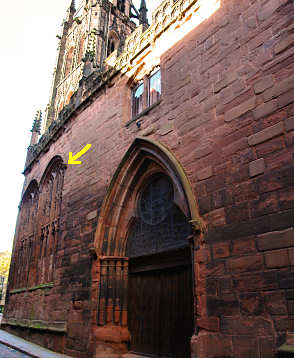
Amongst its many functions, the Guildhall has also seen extensive use as a theatre. The design of the Great Hall with its raised dais easily lent itself to public performances, but not just any performance - because St. Mary's Guildhall became a regular venue for a troupe of players containing without doubt the most famous of any writer or player who ever lived.... the Bard himself, William Shakespeare.
The visits of Shakespeare appear to have been recorded in quite a permanent manner too - for opposite the Guildhall entrance, on the side of the window directly to the left of the South Porch of the Old Cathedral, is a carving of the man.
Using information from the fascinating book 'Shakespeare the Player' by John Southworth, it seems quite likely that the first appearance of William Shakespeare in Coventry was in 1580, when he was almost certainly a sixteen year-old apprentice player with the group known as Worcester's Men. It is known that they performed in Coventry on the 22nd November of that year.
Following that, he would have perfomed here as part of the Admiral's Men from early in 1586, then with the Chamberlain's Men from 1594 onward. The last troupe to which he belonged was the King's Men from 1603 - when King James I succeeded Elizabeth I to the throne of England. Once again, the Guildhall would have been the venue of choice for the performances held in Coventry when the players toured the Midlands. Several more plays would have been performed at the Guildhall over the next few years, including some definitely recorded dates such as 29th October 1608, until Shakespeare's last visit to Coventry in 1614 - just two years before his death from fever at the age of 52.
Of course, apart from simply performing in Coventry, local Blue Badge Tour Guide, Roger Bailey, reminds us that while Shakespeare was writing his 'historical' plays, such as King Henry VI and King Richard II, Coventry gets quite a prominent mention in several of the actors lines - hardly surprising perhaps, considering how important our city was in those far off medieval times!
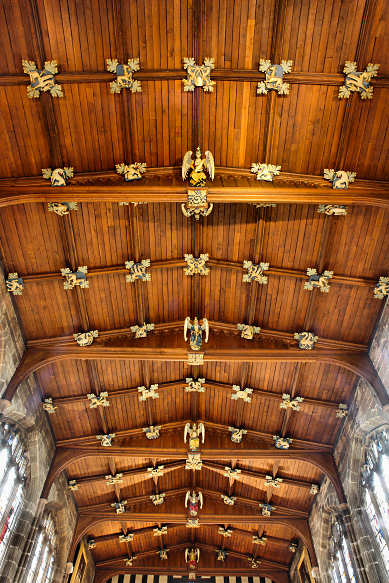
Another of the many highlights to be discovered while touring the guildhall is the ceiling. As with so many medieval buildings, a glance upwards rewards the onlooker with a worthwhile view. It's not apparent unless you happen to know, but much of the roof was destroyed by incendiaries in the blitz, and expert work by modern day craftsmen restored the beautiful ceiling to its former glory.
The carved angels and ceiling bosses also suffered their share of damage in the fire, but despite the devastation much remains original. Clicking on the image of the angel below will take you to a larger montage displaying each of the angels, plus more information about Christopher Kemp Wells, one of the members of the fine team who worked on the restoration of the ceiling.
At this stage of the tour, you may like to visit the Old Cathedral across Bayley Lane.
Website by Rob Orland © 2002 to 2026